Analysis of Management Accounting Principles, Systems, and Costing
VerifiedAdded on 2021/11/16
|9
|2550
|142
Report
AI Summary
This report delves into the multifaceted realm of management accounting, commencing with an explanation of its core principles. It elucidates the crucial role of management accounting and its systems within organizations, highlighting their advantages. The report then provides a comparative analysis of marginal and absorption costing systems, including their application in determining unit costs and preparing income statements. The report showcases the determination of unit costs and the preparation of income statements using both variable costing and absorption costing methods, further illustrating the practical application of these concepts. The report provides a clear understanding of how management accounting principles and systems contribute to effective decision-making and financial management within organizations. The report concludes with a reference list of sources used.
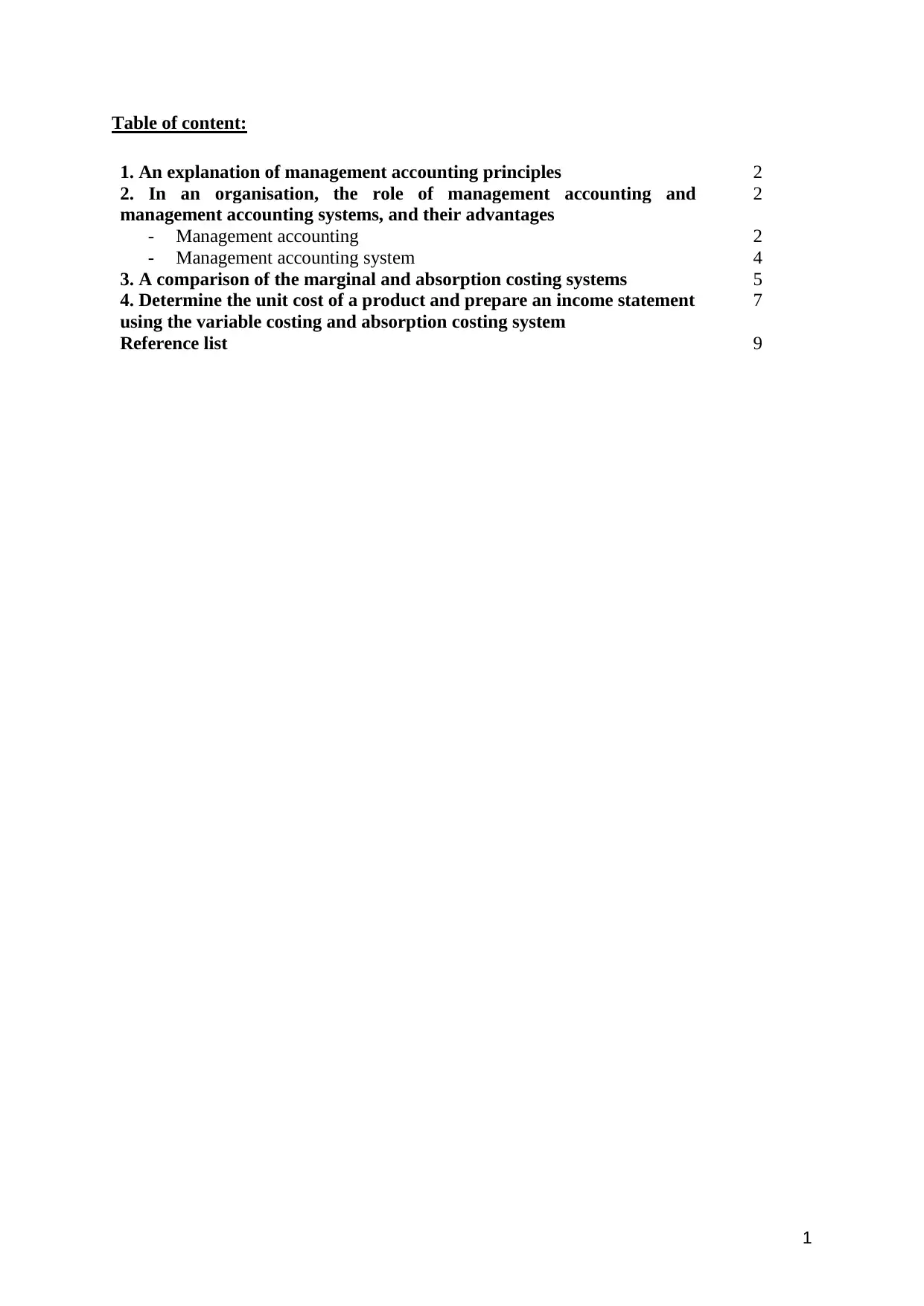
1
Table of content:
1. An explanation of management accounting principles 2
2. In an organisation, the role of management accounting and
management accounting systems, and their advantages
2
- Management accounting 2
- Management accounting system 4
3. A comparison of the marginal and absorption costing systems 5
4. Determine the unit cost of a product and prepare an income statement
using the variable costing and absorption costing system
7
Reference list 9
Table of content:
1. An explanation of management accounting principles 2
2. In an organisation, the role of management accounting and
management accounting systems, and their advantages
2
- Management accounting 2
- Management accounting system 4
3. A comparison of the marginal and absorption costing systems 5
4. Determine the unit cost of a product and prepare an income statement
using the variable costing and absorption costing system
7
Reference list 9
Paraphrase This Document
Need a fresh take? Get an instant paraphrase of this document with our AI Paraphraser
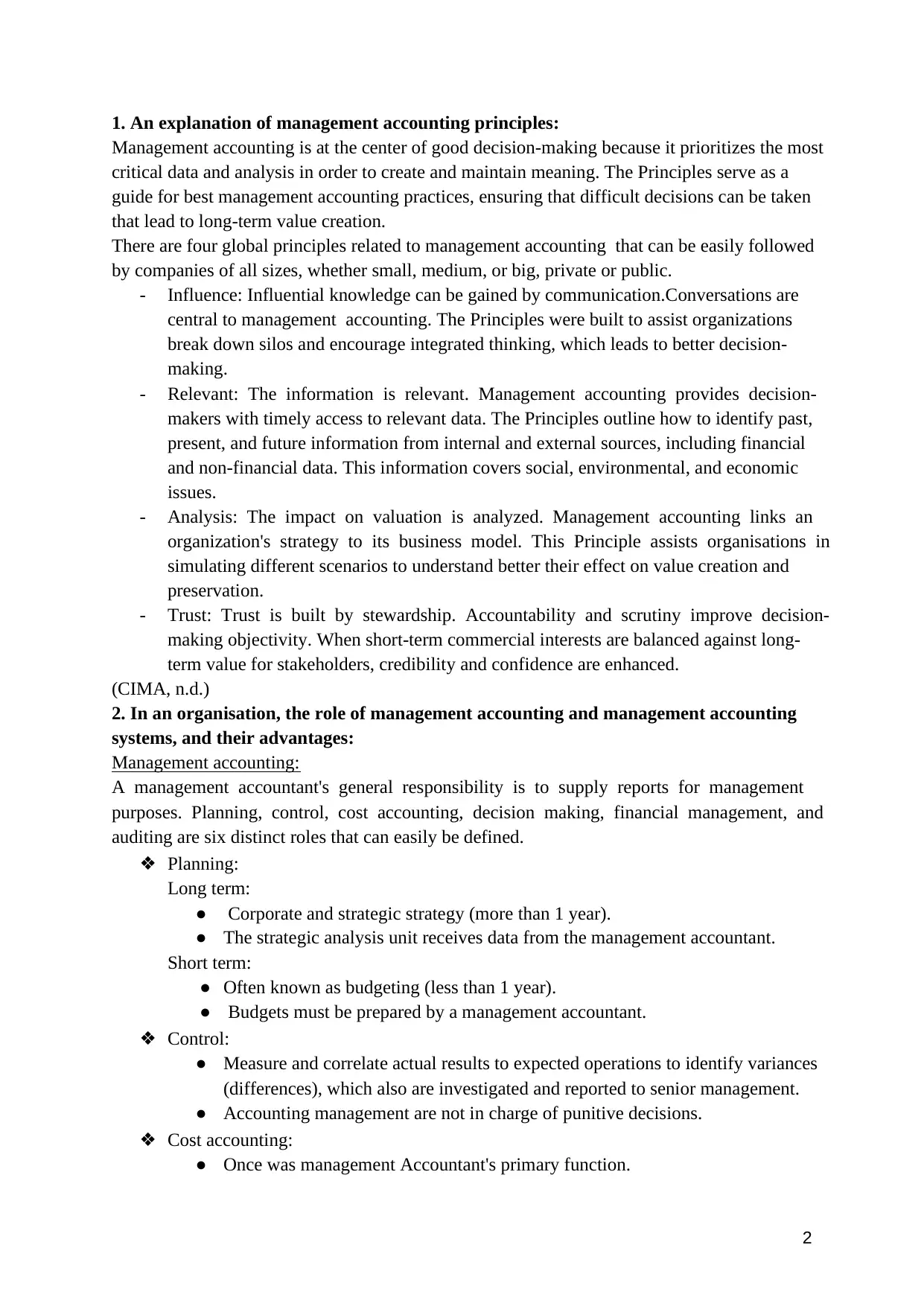
2
1. An explanation of management accounting principles:
Management accounting is at the center of good decision-making because it prioritizes the most
critical data and analysis in order to create and maintain meaning. The Principles serve as a
guide for best management accounting practices, ensuring that difficult decisions can be taken
that lead to long-term value creation.
There are four global principles related to management accounting that can be easily followed
by companies of all sizes, whether small, medium, or big, private or public.
- Influence: Influential knowledge can be gained by communication.Conversations are
central to management accounting. The Principles were built to assist organizations
break down silos and encourage integrated thinking, which leads to better decision-
making.
- Relevant: The information is relevant. Management accounting provides decision-
makers with timely access to relevant data. The Principles outline how to identify past,
present, and future information from internal and external sources, including financial
and non-financial data. This information covers social, environmental, and economic
issues.
- Analysis: The impact on valuation is analyzed. Management accounting links an
organization's strategy to its business model. This Principle assists organisations in
simulating different scenarios to understand better their effect on value creation and
preservation.
- Trust: Trust is built by stewardship. Accountability and scrutiny improve decision-
making objectivity. When short-term commercial interests are balanced against long-
term value for stakeholders, credibility and confidence are enhanced.
(CIMA, n.d.)
2. In an organisation, the role of management accounting and management accounting
systems, and their advantages:
Management accounting:
A management accountant's general responsibility is to supply reports for management
purposes. Planning, control, cost accounting, decision making, financial management, and
auditing are six distinct roles that can easily be defined.
❖ Planning:
Long term:
● Corporate and strategic strategy (more than 1 year).
● The strategic analysis unit receives data from the management accountant.
Short term:
● Often known as budgeting (less than 1 year).
● Budgets must be prepared by a management accountant.
❖ Control:
● Measure and correlate actual results to expected operations to identify variances
(differences), which also are investigated and reported to senior management.
● Accounting management are not in charge of punitive decisions.
❖ Cost accounting:
● Once was management Accountant's primary function.
1. An explanation of management accounting principles:
Management accounting is at the center of good decision-making because it prioritizes the most
critical data and analysis in order to create and maintain meaning. The Principles serve as a
guide for best management accounting practices, ensuring that difficult decisions can be taken
that lead to long-term value creation.
There are four global principles related to management accounting that can be easily followed
by companies of all sizes, whether small, medium, or big, private or public.
- Influence: Influential knowledge can be gained by communication.Conversations are
central to management accounting. The Principles were built to assist organizations
break down silos and encourage integrated thinking, which leads to better decision-
making.
- Relevant: The information is relevant. Management accounting provides decision-
makers with timely access to relevant data. The Principles outline how to identify past,
present, and future information from internal and external sources, including financial
and non-financial data. This information covers social, environmental, and economic
issues.
- Analysis: The impact on valuation is analyzed. Management accounting links an
organization's strategy to its business model. This Principle assists organisations in
simulating different scenarios to understand better their effect on value creation and
preservation.
- Trust: Trust is built by stewardship. Accountability and scrutiny improve decision-
making objectivity. When short-term commercial interests are balanced against long-
term value for stakeholders, credibility and confidence are enhanced.
(CIMA, n.d.)
2. In an organisation, the role of management accounting and management accounting
systems, and their advantages:
Management accounting:
A management accountant's general responsibility is to supply reports for management
purposes. Planning, control, cost accounting, decision making, financial management, and
auditing are six distinct roles that can easily be defined.
❖ Planning:
Long term:
● Corporate and strategic strategy (more than 1 year).
● The strategic analysis unit receives data from the management accountant.
Short term:
● Often known as budgeting (less than 1 year).
● Budgets must be prepared by a management accountant.
❖ Control:
● Measure and correlate actual results to expected operations to identify variances
(differences), which also are investigated and reported to senior management.
● Accounting management are not in charge of punitive decisions.
❖ Cost accounting:
● Once was management Accountant's primary function.
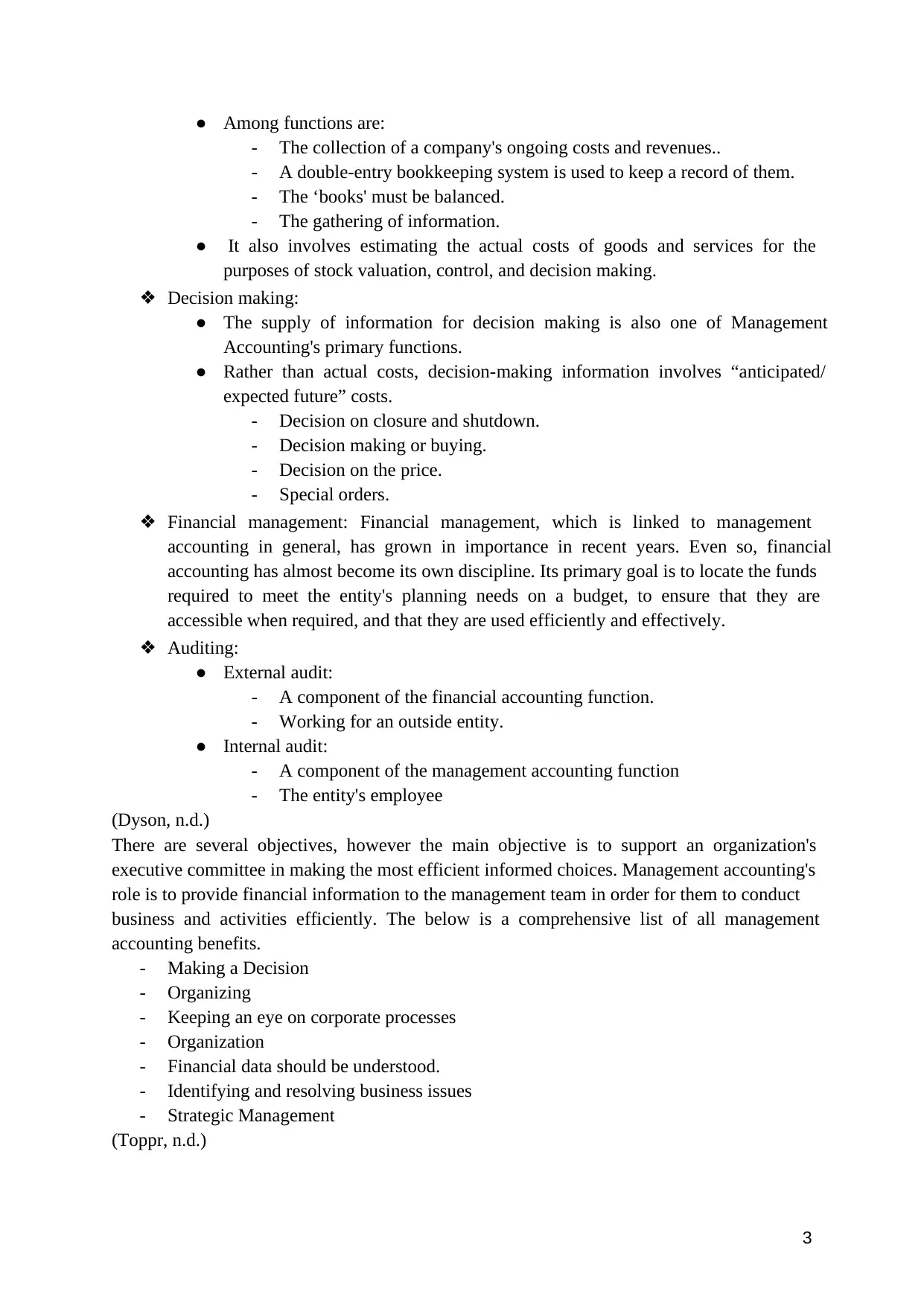
3
● Among functions are:
- The collection of a company's ongoing costs and revenues..
- A double-entry bookkeeping system is used to keep a record of them.
- The ‘books' must be balanced.
- The gathering of information.
● It also involves estimating the actual costs of goods and services for the
purposes of stock valuation, control, and decision making.
❖ Decision making:
● The supply of information for decision making is also one of Management
Accounting's primary functions.
● Rather than actual costs, decision-making information involves “anticipated/
expected future” costs.
- Decision on closure and shutdown.
- Decision making or buying.
- Decision on the price.
- Special orders.
❖ Financial management: Financial management, which is linked to management
accounting in general, has grown in importance in recent years. Even so, financial
accounting has almost become its own discipline. Its primary goal is to locate the funds
required to meet the entity's planning needs on a budget, to ensure that they are
accessible when required, and that they are used efficiently and effectively.
❖ Auditing:
● External audit:
- A component of the financial accounting function.
- Working for an outside entity.
● Internal audit:
- A component of the management accounting function
- The entity's employee
(Dyson, n.d.)
There are several objectives, however the main objective is to support an organization's
executive committee in making the most efficient informed choices. Management accounting's
role is to provide financial information to the management team in order for them to conduct
business and activities efficiently. The below is a comprehensive list of all management
accounting benefits.
- Making a Decision
- Organizing
- Keeping an eye on corporate processes
- Organization
- Financial data should be understood.
- Identifying and resolving business issues
- Strategic Management
(Toppr, n.d.)
● Among functions are:
- The collection of a company's ongoing costs and revenues..
- A double-entry bookkeeping system is used to keep a record of them.
- The ‘books' must be balanced.
- The gathering of information.
● It also involves estimating the actual costs of goods and services for the
purposes of stock valuation, control, and decision making.
❖ Decision making:
● The supply of information for decision making is also one of Management
Accounting's primary functions.
● Rather than actual costs, decision-making information involves “anticipated/
expected future” costs.
- Decision on closure and shutdown.
- Decision making or buying.
- Decision on the price.
- Special orders.
❖ Financial management: Financial management, which is linked to management
accounting in general, has grown in importance in recent years. Even so, financial
accounting has almost become its own discipline. Its primary goal is to locate the funds
required to meet the entity's planning needs on a budget, to ensure that they are
accessible when required, and that they are used efficiently and effectively.
❖ Auditing:
● External audit:
- A component of the financial accounting function.
- Working for an outside entity.
● Internal audit:
- A component of the management accounting function
- The entity's employee
(Dyson, n.d.)
There are several objectives, however the main objective is to support an organization's
executive committee in making the most efficient informed choices. Management accounting's
role is to provide financial information to the management team in order for them to conduct
business and activities efficiently. The below is a comprehensive list of all management
accounting benefits.
- Making a Decision
- Organizing
- Keeping an eye on corporate processes
- Organization
- Financial data should be understood.
- Identifying and resolving business issues
- Strategic Management
(Toppr, n.d.)
⊘ This is a preview!⊘
Do you want full access?
Subscribe today to unlock all pages.

Trusted by 1+ million students worldwide
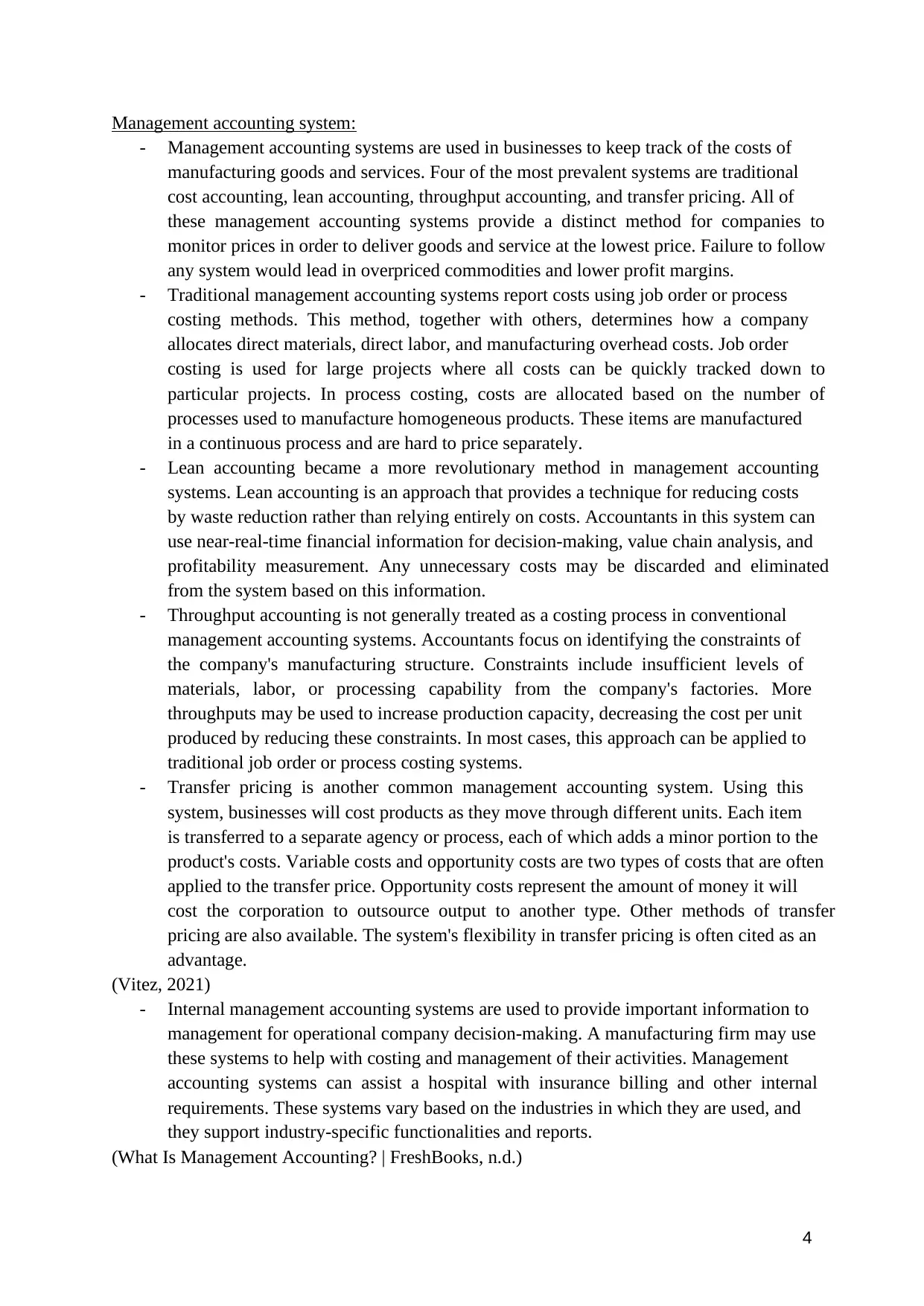
4
Management accounting system:
- Management accounting systems are used in businesses to keep track of the costs of
manufacturing goods and services. Four of the most prevalent systems are traditional
cost accounting, lean accounting, throughput accounting, and transfer pricing. All of
these management accounting systems provide a distinct method for companies to
monitor prices in order to deliver goods and service at the lowest price. Failure to follow
any system would lead in overpriced commodities and lower profit margins.
- Traditional management accounting systems report costs using job order or process
costing methods. This method, together with others, determines how a company
allocates direct materials, direct labor, and manufacturing overhead costs. Job order
costing is used for large projects where all costs can be quickly tracked down to
particular projects. In process costing, costs are allocated based on the number of
processes used to manufacture homogeneous products. These items are manufactured
in a continuous process and are hard to price separately.
- Lean accounting became a more revolutionary method in management accounting
systems. Lean accounting is an approach that provides a technique for reducing costs
by waste reduction rather than relying entirely on costs. Accountants in this system can
use near-real-time financial information for decision-making, value chain analysis, and
profitability measurement. Any unnecessary costs may be discarded and eliminated
from the system based on this information.
- Throughput accounting is not generally treated as a costing process in conventional
management accounting systems. Accountants focus on identifying the constraints of
the company's manufacturing structure. Constraints include insufficient levels of
materials, labor, or processing capability from the company's factories. More
throughputs may be used to increase production capacity, decreasing the cost per unit
produced by reducing these constraints. In most cases, this approach can be applied to
traditional job order or process costing systems.
- Transfer pricing is another common management accounting system. Using this
system, businesses will cost products as they move through different units. Each item
is transferred to a separate agency or process, each of which adds a minor portion to the
product's costs. Variable costs and opportunity costs are two types of costs that are often
applied to the transfer price. Opportunity costs represent the amount of money it will
cost the corporation to outsource output to another type. Other methods of transfer
pricing are also available. The system's flexibility in transfer pricing is often cited as an
advantage.
(Vitez, 2021)
- Internal management accounting systems are used to provide important information to
management for operational company decision-making. A manufacturing firm may use
these systems to help with costing and management of their activities. Management
accounting systems can assist a hospital with insurance billing and other internal
requirements. These systems vary based on the industries in which they are used, and
they support industry-specific functionalities and reports.
(What Is Management Accounting? | FreshBooks, n.d.)
Management accounting system:
- Management accounting systems are used in businesses to keep track of the costs of
manufacturing goods and services. Four of the most prevalent systems are traditional
cost accounting, lean accounting, throughput accounting, and transfer pricing. All of
these management accounting systems provide a distinct method for companies to
monitor prices in order to deliver goods and service at the lowest price. Failure to follow
any system would lead in overpriced commodities and lower profit margins.
- Traditional management accounting systems report costs using job order or process
costing methods. This method, together with others, determines how a company
allocates direct materials, direct labor, and manufacturing overhead costs. Job order
costing is used for large projects where all costs can be quickly tracked down to
particular projects. In process costing, costs are allocated based on the number of
processes used to manufacture homogeneous products. These items are manufactured
in a continuous process and are hard to price separately.
- Lean accounting became a more revolutionary method in management accounting
systems. Lean accounting is an approach that provides a technique for reducing costs
by waste reduction rather than relying entirely on costs. Accountants in this system can
use near-real-time financial information for decision-making, value chain analysis, and
profitability measurement. Any unnecessary costs may be discarded and eliminated
from the system based on this information.
- Throughput accounting is not generally treated as a costing process in conventional
management accounting systems. Accountants focus on identifying the constraints of
the company's manufacturing structure. Constraints include insufficient levels of
materials, labor, or processing capability from the company's factories. More
throughputs may be used to increase production capacity, decreasing the cost per unit
produced by reducing these constraints. In most cases, this approach can be applied to
traditional job order or process costing systems.
- Transfer pricing is another common management accounting system. Using this
system, businesses will cost products as they move through different units. Each item
is transferred to a separate agency or process, each of which adds a minor portion to the
product's costs. Variable costs and opportunity costs are two types of costs that are often
applied to the transfer price. Opportunity costs represent the amount of money it will
cost the corporation to outsource output to another type. Other methods of transfer
pricing are also available. The system's flexibility in transfer pricing is often cited as an
advantage.
(Vitez, 2021)
- Internal management accounting systems are used to provide important information to
management for operational company decision-making. A manufacturing firm may use
these systems to help with costing and management of their activities. Management
accounting systems can assist a hospital with insurance billing and other internal
requirements. These systems vary based on the industries in which they are used, and
they support industry-specific functionalities and reports.
(What Is Management Accounting? | FreshBooks, n.d.)
Paraphrase This Document
Need a fresh take? Get an instant paraphrase of this document with our AI Paraphraser
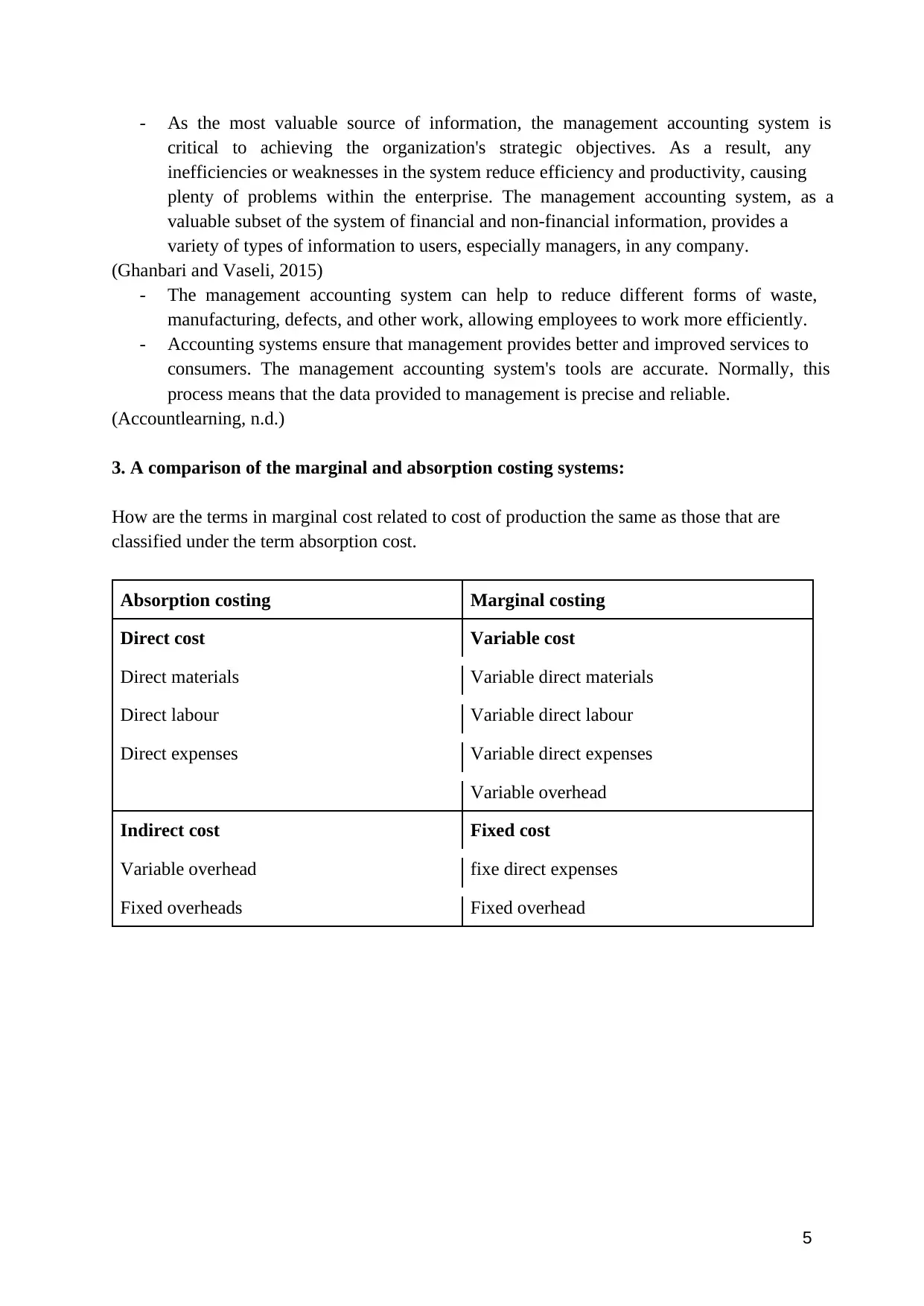
5
- As the most valuable source of information, the management accounting system is
critical to achieving the organization's strategic objectives. As a result, any
inefficiencies or weaknesses in the system reduce efficiency and productivity, causing
plenty of problems within the enterprise. The management accounting system, as a
valuable subset of the system of financial and non-financial information, provides a
variety of types of information to users, especially managers, in any company.
(Ghanbari and Vaseli, 2015)
- The management accounting system can help to reduce different forms of waste,
manufacturing, defects, and other work, allowing employees to work more efficiently.
- Accounting systems ensure that management provides better and improved services to
consumers. The management accounting system's tools are accurate. Normally, this
process means that the data provided to management is precise and reliable.
(Accountlearning, n.d.)
3. A comparison of the marginal and absorption costing systems:
How are the terms in marginal cost related to cost of production the same as those that are
classified under the term absorption cost.
Absorption costing Marginal costing
Direct cost Variable cost
Direct materials Variable direct materials
Direct labour Variable direct labour
Direct expenses Variable direct expenses
Variable overhead
Indirect cost Fixed cost
Variable overhead fixe direct expenses
Fixed overheads Fixed overhead
- As the most valuable source of information, the management accounting system is
critical to achieving the organization's strategic objectives. As a result, any
inefficiencies or weaknesses in the system reduce efficiency and productivity, causing
plenty of problems within the enterprise. The management accounting system, as a
valuable subset of the system of financial and non-financial information, provides a
variety of types of information to users, especially managers, in any company.
(Ghanbari and Vaseli, 2015)
- The management accounting system can help to reduce different forms of waste,
manufacturing, defects, and other work, allowing employees to work more efficiently.
- Accounting systems ensure that management provides better and improved services to
consumers. The management accounting system's tools are accurate. Normally, this
process means that the data provided to management is precise and reliable.
(Accountlearning, n.d.)
3. A comparison of the marginal and absorption costing systems:
How are the terms in marginal cost related to cost of production the same as those that are
classified under the term absorption cost.
Absorption costing Marginal costing
Direct cost Variable cost
Direct materials Variable direct materials
Direct labour Variable direct labour
Direct expenses Variable direct expenses
Variable overhead
Indirect cost Fixed cost
Variable overhead fixe direct expenses
Fixed overheads Fixed overhead
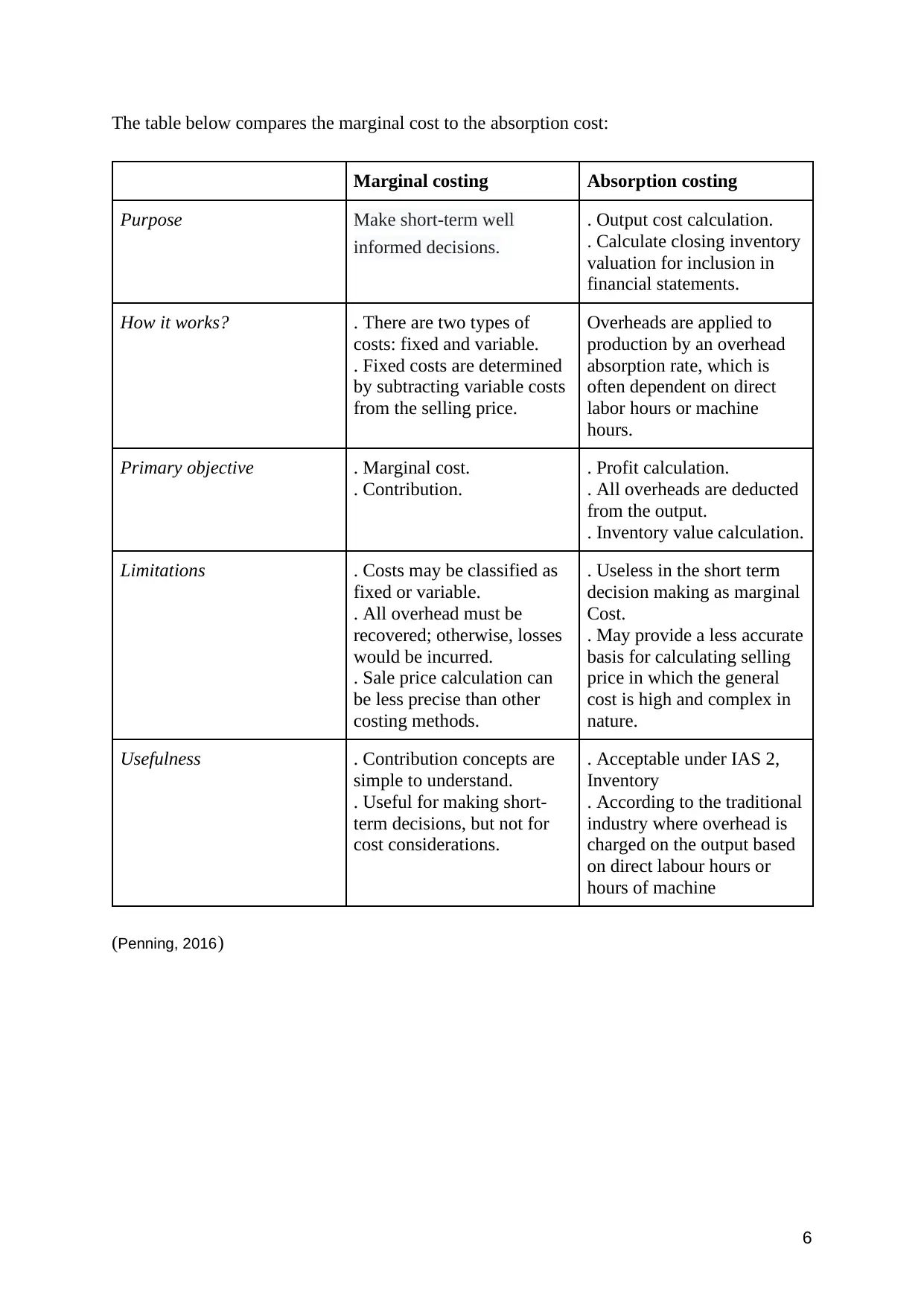
6
The table below compares the marginal cost to the absorption cost:
Marginal costing Absorption costing
Purpose Make short-term well
informed decisions.
. Output cost calculation.
. Calculate closing inventory
valuation for inclusion in
financial statements.
How it works? . There are two types of
costs: fixed and variable.
. Fixed costs are determined
by subtracting variable costs
from the selling price.
Overheads are applied to
production by an overhead
absorption rate, which is
often dependent on direct
labor hours or machine
hours.
Primary objective . Marginal cost.
. Contribution.
. Profit calculation.
. All overheads are deducted
from the output.
. Inventory value calculation.
Limitations . Costs may be classified as
fixed or variable.
. All overhead must be
recovered; otherwise, losses
would be incurred.
. Sale price calculation can
be less precise than other
costing methods.
. Useless in the short term
decision making as marginal
Cost.
. May provide a less accurate
basis for calculating selling
price in which the general
cost is high and complex in
nature.
Usefulness . Contribution concepts are
simple to understand.
. Useful for making short-
term decisions, but not for
cost considerations.
. Acceptable under IAS 2,
Inventory
. According to the traditional
industry where overhead is
charged on the output based
on direct labour hours or
hours of machine
(Penning, 2016)
The table below compares the marginal cost to the absorption cost:
Marginal costing Absorption costing
Purpose Make short-term well
informed decisions.
. Output cost calculation.
. Calculate closing inventory
valuation for inclusion in
financial statements.
How it works? . There are two types of
costs: fixed and variable.
. Fixed costs are determined
by subtracting variable costs
from the selling price.
Overheads are applied to
production by an overhead
absorption rate, which is
often dependent on direct
labor hours or machine
hours.
Primary objective . Marginal cost.
. Contribution.
. Profit calculation.
. All overheads are deducted
from the output.
. Inventory value calculation.
Limitations . Costs may be classified as
fixed or variable.
. All overhead must be
recovered; otherwise, losses
would be incurred.
. Sale price calculation can
be less precise than other
costing methods.
. Useless in the short term
decision making as marginal
Cost.
. May provide a less accurate
basis for calculating selling
price in which the general
cost is high and complex in
nature.
Usefulness . Contribution concepts are
simple to understand.
. Useful for making short-
term decisions, but not for
cost considerations.
. Acceptable under IAS 2,
Inventory
. According to the traditional
industry where overhead is
charged on the output based
on direct labour hours or
hours of machine
(Penning, 2016)
⊘ This is a preview!⊘
Do you want full access?
Subscribe today to unlock all pages.

Trusted by 1+ million students worldwide
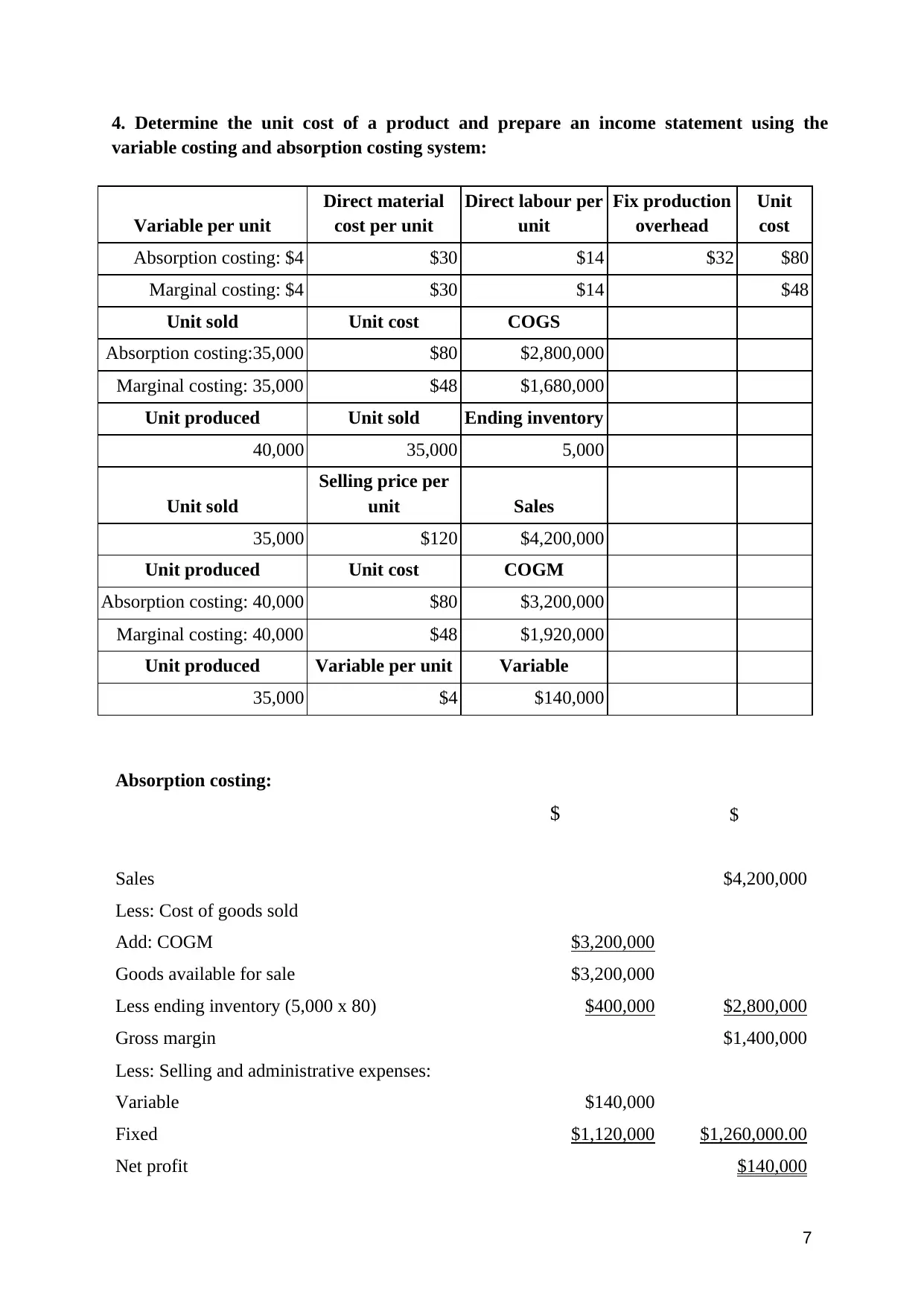
7
4. Determine the unit cost of a product and prepare an income statement using the
variable costing and absorption costing system:
Variable per unit
Direct material
cost per unit
Direct labour per
unit
Fix production
overhead
Unit
cost
Absorption costing: $4 $30 $14 $32 $80
Marginal costing: $4 $30 $14 $48
Unit sold Unit cost COGS
Absorption costing:35,000 $80 $2,800,000
Marginal costing: 35,000 $48 $1,680,000
Unit produced Unit sold Ending inventory
40,000 35,000 5,000
Unit sold
Selling price per
unit Sales
35,000 $120 $4,200,000
Unit produced Unit cost COGM
Absorption costing: 40,000 $80 $3,200,000
Marginal costing: 40,000 $48 $1,920,000
Unit produced Variable per unit Variable
35,000 $4 $140,000
Absorption costing:
$ $
Sales $4,200,000
Less: Cost of goods sold
Add: COGM $3,200,000
Goods available for sale $3,200,000
Less ending inventory (5,000 x 80) $400,000 $2,800,000
Gross margin $1,400,000
Less: Selling and administrative expenses:
Variable $140,000
Fixed $1,120,000 $1,260,000.00
Net profit $140,000
4. Determine the unit cost of a product and prepare an income statement using the
variable costing and absorption costing system:
Variable per unit
Direct material
cost per unit
Direct labour per
unit
Fix production
overhead
Unit
cost
Absorption costing: $4 $30 $14 $32 $80
Marginal costing: $4 $30 $14 $48
Unit sold Unit cost COGS
Absorption costing:35,000 $80 $2,800,000
Marginal costing: 35,000 $48 $1,680,000
Unit produced Unit sold Ending inventory
40,000 35,000 5,000
Unit sold
Selling price per
unit Sales
35,000 $120 $4,200,000
Unit produced Unit cost COGM
Absorption costing: 40,000 $80 $3,200,000
Marginal costing: 40,000 $48 $1,920,000
Unit produced Variable per unit Variable
35,000 $4 $140,000
Absorption costing:
$ $
Sales $4,200,000
Less: Cost of goods sold
Add: COGM $3,200,000
Goods available for sale $3,200,000
Less ending inventory (5,000 x 80) $400,000 $2,800,000
Gross margin $1,400,000
Less: Selling and administrative expenses:
Variable $140,000
Fixed $1,120,000 $1,260,000.00
Net profit $140,000
Paraphrase This Document
Need a fresh take? Get an instant paraphrase of this document with our AI Paraphraser
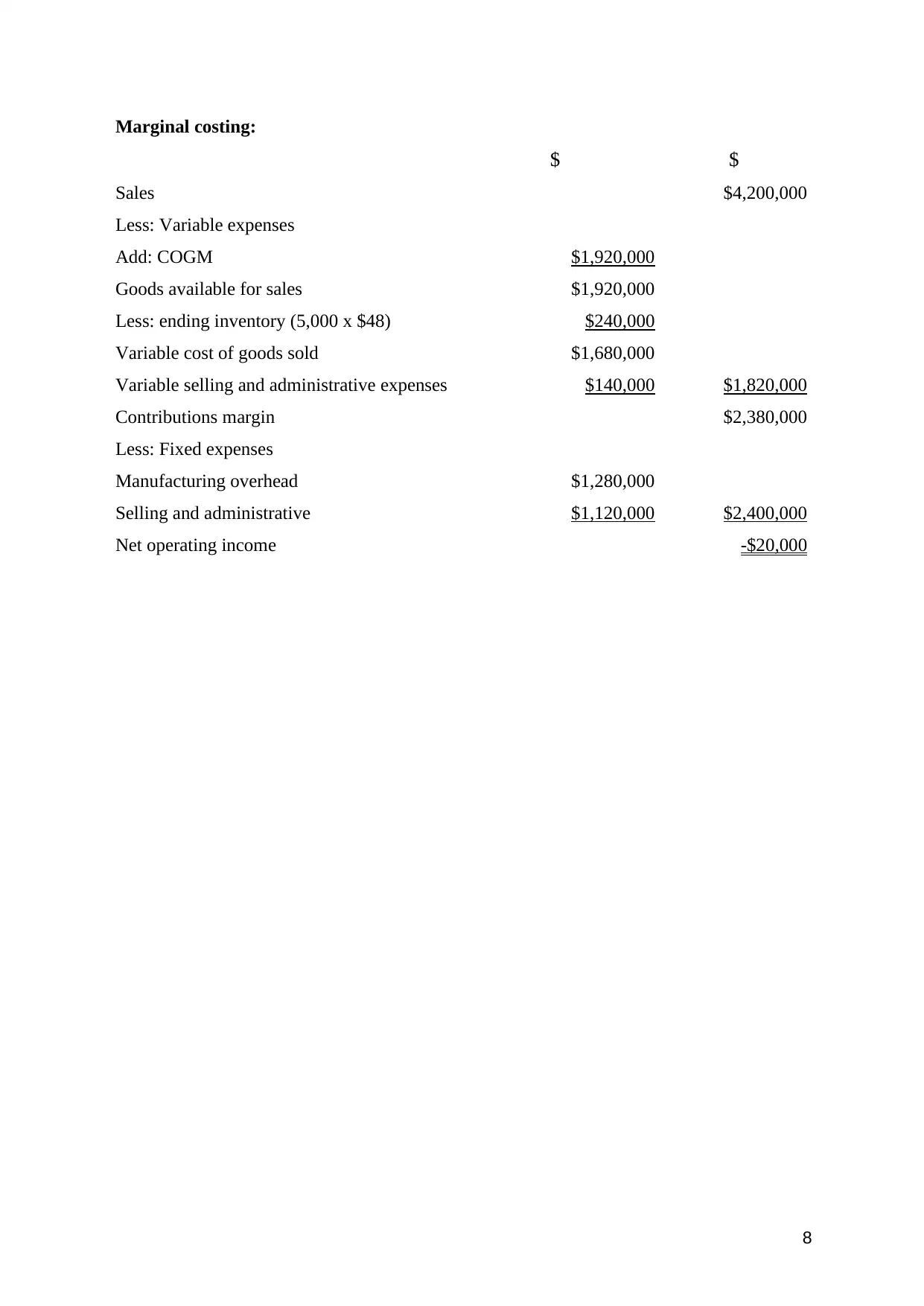
8
Marginal costing:
$ $
Sales $4,200,000
Less: Variable expenses
Add: COGM $1,920,000
Goods available for sales $1,920,000
Less: ending inventory (5,000 x $48) $240,000
Variable cost of goods sold $1,680,000
Variable selling and administrative expenses $140,000 $1,820,000
Contributions margin $2,380,000
Less: Fixed expenses
Manufacturing overhead $1,280,000
Selling and administrative $1,120,000 $2,400,000
Net operating income -$20,000
Marginal costing:
$ $
Sales $4,200,000
Less: Variable expenses
Add: COGM $1,920,000
Goods available for sales $1,920,000
Less: ending inventory (5,000 x $48) $240,000
Variable cost of goods sold $1,680,000
Variable selling and administrative expenses $140,000 $1,820,000
Contributions margin $2,380,000
Less: Fixed expenses
Manufacturing overhead $1,280,000
Selling and administrative $1,120,000 $2,400,000
Net operating income -$20,000
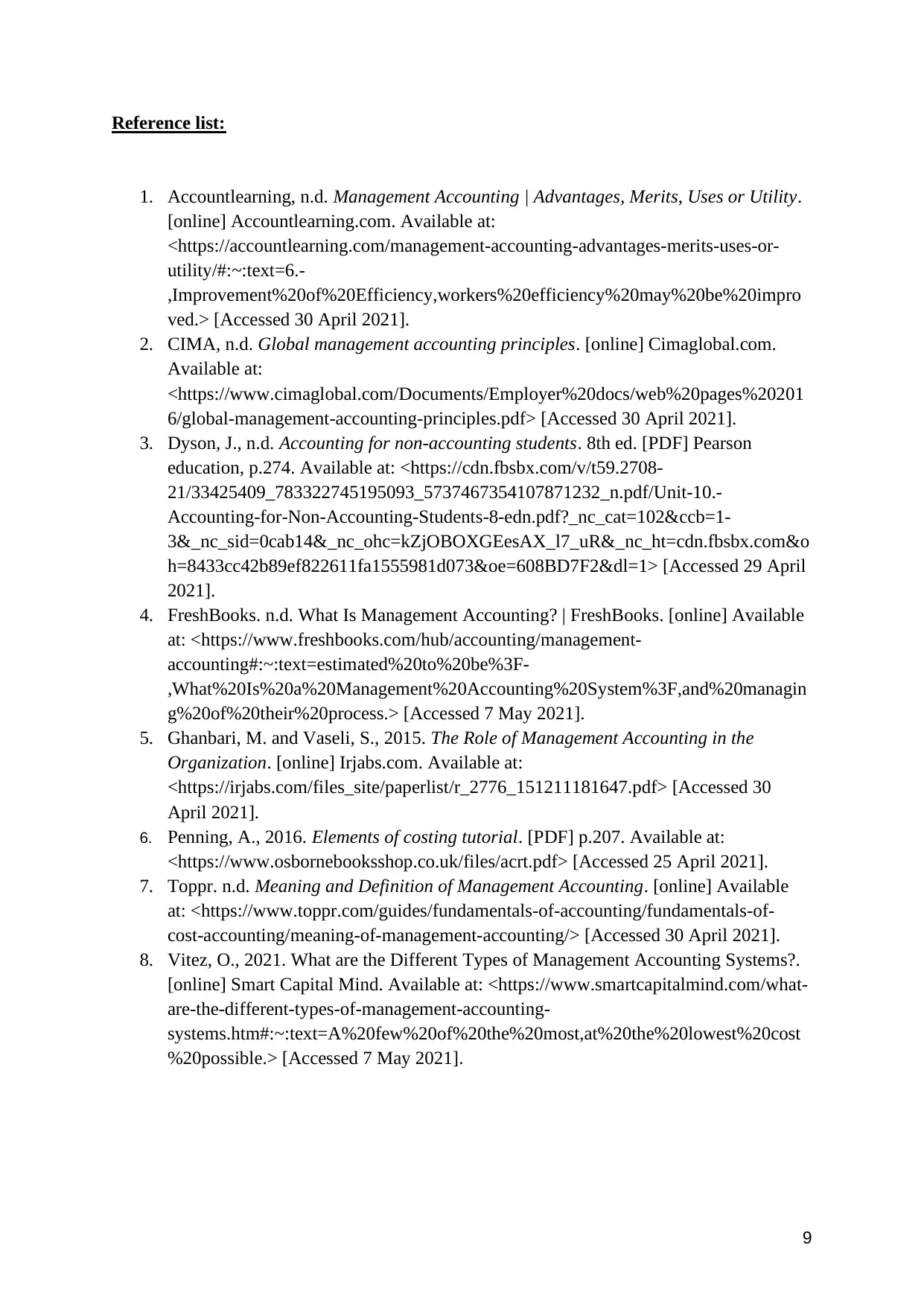
9
Reference list:
1. Accountlearning, n.d. Management Accounting | Advantages, Merits, Uses or Utility.
[online] Accountlearning.com. Available at:
<https://accountlearning.com/management-accounting-advantages-merits-uses-or-
utility/#:~:text=6.-
,Improvement%20of%20Efficiency,workers%20efficiency%20may%20be%20impro
ved.> [Accessed 30 April 2021].
2. CIMA, n.d. Global management accounting principles. [online] Cimaglobal.com.
Available at:
<https://www.cimaglobal.com/Documents/Employer%20docs/web%20pages%20201
6/global-management-accounting-principles.pdf> [Accessed 30 April 2021].
3. Dyson, J., n.d. Accounting for non-accounting students. 8th ed. [PDF] Pearson
education, p.274. Available at: <https://cdn.fbsbx.com/v/t59.2708-
21/33425409_783322745195093_5737467354107871232_n.pdf/Unit-10.-
Accounting-for-Non-Accounting-Students-8-edn.pdf?_nc_cat=102&ccb=1-
3&_nc_sid=0cab14&_nc_ohc=kZjOBOXGEesAX_l7_uR&_nc_ht=cdn.fbsbx.com&o
h=8433cc42b89ef822611fa1555981d073&oe=608BD7F2&dl=1> [Accessed 29 April
2021].
4. FreshBooks. n.d. What Is Management Accounting? | FreshBooks. [online] Available
at: <https://www.freshbooks.com/hub/accounting/management-
accounting#:~:text=estimated%20to%20be%3F-
,What%20Is%20a%20Management%20Accounting%20System%3F,and%20managin
g%20of%20their%20process.> [Accessed 7 May 2021].
5. Ghanbari, M. and Vaseli, S., 2015. The Role of Management Accounting in the
Organization. [online] Irjabs.com. Available at:
<https://irjabs.com/files_site/paperlist/r_2776_151211181647.pdf> [Accessed 30
April 2021].
6. Penning, A., 2016. Elements of costing tutorial. [PDF] p.207. Available at:
<https://www.osbornebooksshop.co.uk/files/acrt.pdf> [Accessed 25 April 2021].
7. Toppr. n.d. Meaning and Definition of Management Accounting. [online] Available
at: <https://www.toppr.com/guides/fundamentals-of-accounting/fundamentals-of-
cost-accounting/meaning-of-management-accounting/> [Accessed 30 April 2021].
8. Vitez, O., 2021. What are the Different Types of Management Accounting Systems?.
[online] Smart Capital Mind. Available at: <https://www.smartcapitalmind.com/what-
are-the-different-types-of-management-accounting-
systems.htm#:~:text=A%20few%20of%20the%20most,at%20the%20lowest%20cost
%20possible.> [Accessed 7 May 2021].
Reference list:
1. Accountlearning, n.d. Management Accounting | Advantages, Merits, Uses or Utility.
[online] Accountlearning.com. Available at:
<https://accountlearning.com/management-accounting-advantages-merits-uses-or-
utility/#:~:text=6.-
,Improvement%20of%20Efficiency,workers%20efficiency%20may%20be%20impro
ved.> [Accessed 30 April 2021].
2. CIMA, n.d. Global management accounting principles. [online] Cimaglobal.com.
Available at:
<https://www.cimaglobal.com/Documents/Employer%20docs/web%20pages%20201
6/global-management-accounting-principles.pdf> [Accessed 30 April 2021].
3. Dyson, J., n.d. Accounting for non-accounting students. 8th ed. [PDF] Pearson
education, p.274. Available at: <https://cdn.fbsbx.com/v/t59.2708-
21/33425409_783322745195093_5737467354107871232_n.pdf/Unit-10.-
Accounting-for-Non-Accounting-Students-8-edn.pdf?_nc_cat=102&ccb=1-
3&_nc_sid=0cab14&_nc_ohc=kZjOBOXGEesAX_l7_uR&_nc_ht=cdn.fbsbx.com&o
h=8433cc42b89ef822611fa1555981d073&oe=608BD7F2&dl=1> [Accessed 29 April
2021].
4. FreshBooks. n.d. What Is Management Accounting? | FreshBooks. [online] Available
at: <https://www.freshbooks.com/hub/accounting/management-
accounting#:~:text=estimated%20to%20be%3F-
,What%20Is%20a%20Management%20Accounting%20System%3F,and%20managin
g%20of%20their%20process.> [Accessed 7 May 2021].
5. Ghanbari, M. and Vaseli, S., 2015. The Role of Management Accounting in the
Organization. [online] Irjabs.com. Available at:
<https://irjabs.com/files_site/paperlist/r_2776_151211181647.pdf> [Accessed 30
April 2021].
6. Penning, A., 2016. Elements of costing tutorial. [PDF] p.207. Available at:
<https://www.osbornebooksshop.co.uk/files/acrt.pdf> [Accessed 25 April 2021].
7. Toppr. n.d. Meaning and Definition of Management Accounting. [online] Available
at: <https://www.toppr.com/guides/fundamentals-of-accounting/fundamentals-of-
cost-accounting/meaning-of-management-accounting/> [Accessed 30 April 2021].
8. Vitez, O., 2021. What are the Different Types of Management Accounting Systems?.
[online] Smart Capital Mind. Available at: <https://www.smartcapitalmind.com/what-
are-the-different-types-of-management-accounting-
systems.htm#:~:text=A%20few%20of%20the%20most,at%20the%20lowest%20cost
%20possible.> [Accessed 7 May 2021].
⊘ This is a preview!⊘
Do you want full access?
Subscribe today to unlock all pages.

Trusted by 1+ million students worldwide
1 out of 9
Related Documents
Your All-in-One AI-Powered Toolkit for Academic Success.
+13062052269
info@desklib.com
Available 24*7 on WhatsApp / Email
![[object Object]](/_next/static/media/star-bottom.7253800d.svg)
Unlock your academic potential
Copyright © 2020–2025 A2Z Services. All Rights Reserved. Developed and managed by ZUCOL.





